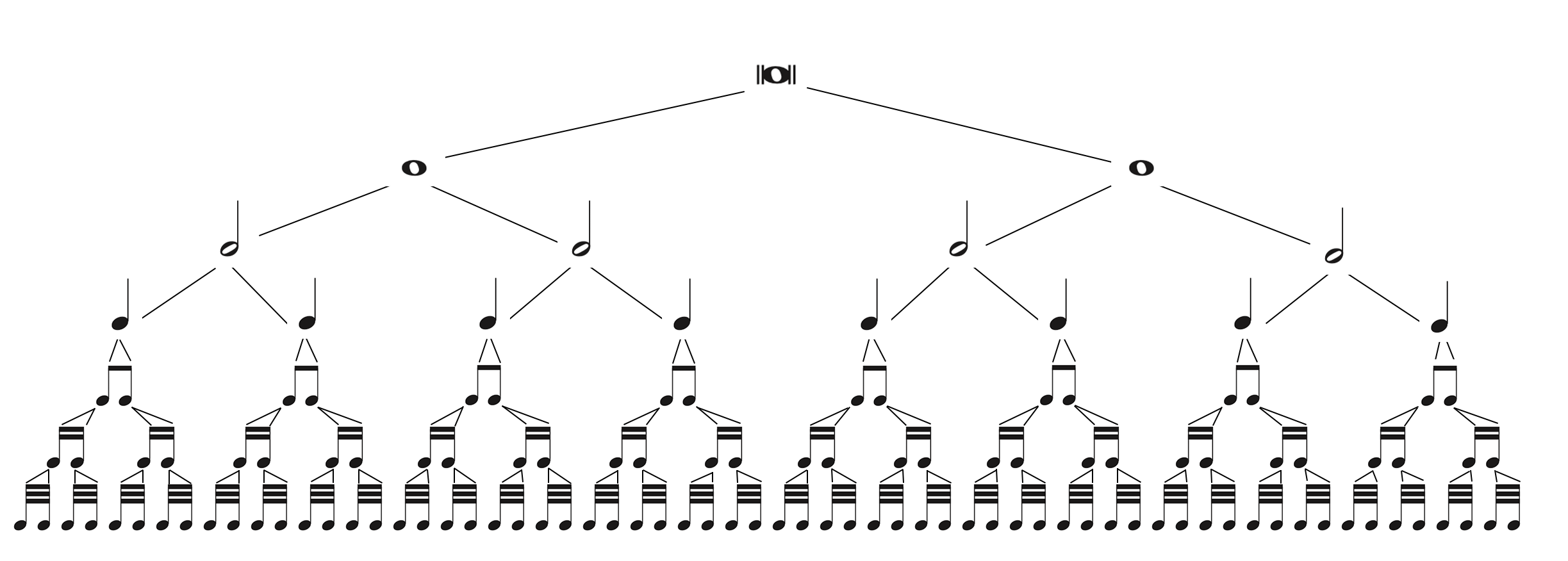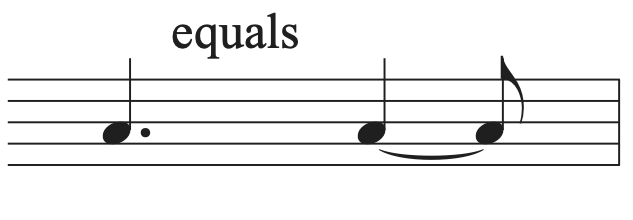1.1 Basics of Rhythm: Tutorial
Rhythm
Rhythm in music consists of patterns of long and short durations of pitches and silences. These patterns are heard in relation to the meter of the music. Rhythm and meter are two different, but interconnected aspects of music. The relationship between rhythm and meter will become clear through exploring rhythm, meter, and beaming in Unit 1.
Rhythmic Symbols
The symbols of rhythmic notation are notes and rests. The example below shows the most commonly used notes in music, though larger and smaller note values exist.

The parts of a note can include noteheads, stems, flags, and beams. Notice how those are notated on a staff.

Noteheads can be open or filled in depending on the type of note used. Noteheads that are filled in have a stem. Stems are drawn an octave in length on the staff, and can be drawn up or down. They are drawn up and on the right side of a note if the note sits below the middle line on the staff. They are drawn down and on the left side of a note if the note sits above the middle line on the staff. Notes that sit on the middle line of the staff can have stems drawn in either direction.

Flags are used on eighth notes as well as those with shorter rhythmic values. Flags are drawn to the right of the note and curve towards the note head. Eighth notes have one flag while notes like sixteenth notes and thirty-second notes have multiple flags.

Beams can be used to join two or more notes with flags together. Notes are beamed together when needed according to the meter, which will be explored in the chapter on beaming.

While notes are the pitched symbols in rhythmic notation, rests are the symbols used to indicated durations of silence. Each note has a corresponding rest of equal length.

Notice that each note and rest is drawn on a specific place on the staff. Whole rests hang down from line 4 to occupy half of space 3. Half rests sit above line 3 and occupy half of space 3. Quarter rests are drawn from space 1 to 4. Eighth notes sit between line 2 and space 3, and sixteenth notes sit on line 1 and extend to space 3. Having a distinct difference in spacing of rests on the staff makes it easier to recognize and read them quickly.
Proportional Notation
Rhythmic values are not fixed units of time. Rhythmic symbols are proportional, meaning that if one rhythm changes value, all of the others also change at the same rate. The relationship between note values does not change. Look at the chart below to see the proportional relationship between note values. Each rhythmic symbol on the chart divides into 2 equal note values of a smaller duration. So, each symbol is twice the duration of the next shorter symbol on the chart and half the duration of the next longer symbol on the chart. For example, a half note divides into 2 quarter notes, and a quarter note divides into 2 eighth notes. That means that there are 4 eighth notes in a half note.

The note that equals one beat in music is defined by the meter of the music. Let’s say that the quarter note equals 1 beat in a given meter. That would mean a half note would equal 2 beats. However, if a piece is written in a meter where the half note equals 1 beat, then the quarter note would be worth half of a beat. So, while the change in meter changed which note on the chart would equal 1 beat, the value relationship between the notes remained the same. A half note is always twice the value of a quarter note.
Ties
A tie is used to add notes together to form a longer rhythmic value. It is a curved line that connects two note heads of the same pitch, creating a new duration that is equal to their sum. To tie more than one note together, separate ties must be used to connect each notehead to the one that follows. Ties can only be used on notes, not on rests. In the example below, two quarter notes tied together, which equals one half note. Four quarter notes tied together equals one whole note.

In contrast to a tie, a slur will connect two or more notes of different pitches together, and is an articulation mark that means to play the notes without articulating any notes contained under the slur mark. A slur does not impact the rhythm of a note, and should not be mistaken for a tie.

Dots
A dot, also known as an augmentation dot, is a symbol added to a note or rest that increases the value of the note or rest by half of its original value. For example, adding a dot to a quarter note would make it equal to a quarter note plus and eighth note in length.

Dots are always drawn directly to the right of a note or rest. If a note is on a space, the dot is drawn in the same space. If a note is on a line, the dot is drawn on the space above that line. Dots on rests are always drawn on the 3rd space on the staff.

Notes and rests can have more than one dot added to them. For multiple dots, the first dot always increases the note by half of its original value, like a regular dot. Any dot following that will increase the value of the note by half of the value of the dot before it. For example, in a double dotted quarter note, the first dot increases the value of the quarter note by an eighth note, which is half its value. The second dot increases the value of the note by half of the first dot, which means half of an eighth note, which would be a sixteenth note.

Bringing Theory to Life

